10 Space-Saving Spice Rack Ideas You’ll Wish You Knew Sooner
If you’ve ever stood in front of a cabinet full of mismatched spice jars, trying to find cumin while the oil’s already heating—trust me, you’re not alone. Most kitchens, no matter how big or small, have one chaotic corner where spice bottles multiply faster than we can use them. I’ve spent years helping clients organize their homes, and the spice zone is almost always the first place that needs a reset.
The good news? You don’t need a massive pantry or a Pinterest-perfect kitchen to fix it. You just need smart storage that fits your cooking style and space. Maybe that’s a pull-out rack beside your stove, a tiered drawer insert, or a few magnetic jars that turn your fridge into prime storage real estate. Once you match the right system to your habits, you’ll actually enjoy cooking again—because you can see, reach, and use everything you own.
By the end, you’ll know which spice setup suits your space, how to keep it clutter-free, and even a few quick tricks to make your daily cooking smoother. So, tell me—what’s your biggest spice-storage struggle right now: lack of space, too many bottles, or no system at all?
Why Your Spice Storage Matters More Than You Think
If you cook often, you already know that spices can make or break a dish. But here’s the thing most people overlook — how you store them can be just as important as how you use them. When spices sit in direct light, heat, or open air, they lose their punch fast. Ground spices, especially, fade within months if they’re left out on a sunny counter or near the stove. According to Wikipedia, even a small change in temperature or humidity can cut their shelf life in half.
So no, storage isn’t just about neat rows and pretty jars — it’s about keeping the flavor alive. And trust me, once you taste the difference between a well-stored spice and one that’s been sitting out too long, you won’t go back.
Spices Lose Potency When Poorly Stored
You’ve probably opened a jar of paprika or cumin that looked fine but tasted… flat. That’s oxidation and light exposure at work.
Here’s what I always tell my clients:
- Keep spices away from heat — never above the stove.
- Use airtight glass jars or tins; plastic doesn’t seal aromas well.
- Store them in a dark, cool cabinet or drawer if possible.
- Label each jar with the date you opened it — small detail, big payoff.
A little discipline here keeps your dishes bold, aromatic, and consistent.
A Chaotic Spice Collection Slows You Down (and Stresses You Out)
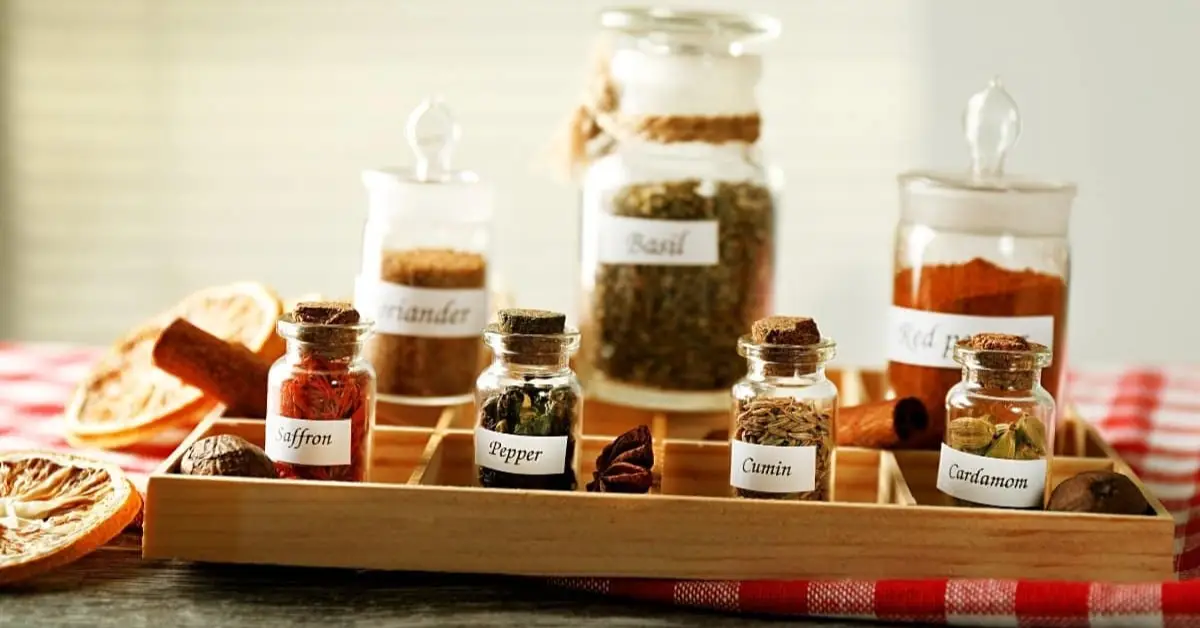
Ever started cooking and realized you spent more time hunting for coriander than actually chopping veggies? That clutter is more than visual — it’s mental noise. When you can’t find what you need, you waste minutes and energy every time you cook.
I’ve seen this in hundreds of kitchens: people own duplicates because they couldn’t find the original jar, or they skip a spice entirely because it’s buried somewhere in the back. The result? Wasted money, wasted flavor, and unnecessary frustration.
Once you organize, you’ll notice how much smoother your cooking routine feels. It’s like muscle memory — when everything has its place, your kitchen flow just clicks.
Good Storage Frees Up Space and Improves Kitchen Flow
A smart spice setup isn’t just tidy; it’s efficient. When your jars fit perfectly, labels face forward, and you can reach what you need without shifting ten others — that’s functional design in action.
Here’s what happens when you store well:
- Countertops look cleaner instantly.
- Cabinets suddenly feel twice as big.
- You stop buying duplicates and start using what you already have.
- Cooking feels more intuitive and less chaotic.
Once your spices are streamlined, every meal becomes easier to start — and easier to clean up after.
How to Choose the Right Spice Storage System for Your Kitchen
Before you jump into racks, jars, and containers, take a step back. Not every kitchen (or cook) needs the same setup. The best spice storage fits your habits, not someone else’s Pinterest board.
Assess Your Kitchen Type & Cooking Habits
Ask yourself:
- Do you cook daily, or just a few times a week?
- Is your kitchen compact, open, or full-sized?
- Do you prefer everything visible, or tucked neatly away?
If you live in an apartment with limited counter space, a magnetic rack on the fridge or a pull-out drawer might be perfect. If you cook elaborate meals often, an open-shelf system near the prep area will save you time. The goal is easy access — not just display.
Inventory Your Spice Collection & Usage Frequency
Before you buy anything, line up all your spices. You might be shocked at how many duplicates you have (looking at you, three jars of oregano). Group them like this:
- Daily use: salt, pepper, chili, cumin, turmeric, garlic powder
- Occasional use: cinnamon, nutmeg, coriander, mustard seeds
- Rare use: specialty blends, whole pods, international spices
Keep the daily-use ones within arm’s reach, and the others in labeled bins or boxes. You’ll instantly reduce clutter and cut down your cooking time.
Budget & DIY vs Premium Products
Not every good idea has to cost a fortune. A few glass jars, drawer inserts, or even recycled baby food containers can work wonders. If you enjoy DIY projects, repurpose old wooden boxes or tea tins — they add personality and cost almost nothing.
But if you prefer something long-lasting and sleek, premium racks with adjustable tiers or pull-out mechanisms are worth the investment. They last years, look great, and make cleaning easier.
My rule of thumb: spend where it improves your daily convenience, not just aesthetics.
Maintenance & Future-Proofing
The secret to keeping your spice system working long-term is consistency. Don’t just organize once — maintain it.
Try this:
- Refill jars immediately after they empty.
- Keep a small notepad or phone list for spices that need restocking.
- Wipe shelves monthly to prevent residue build-up.
- Update labels when you buy a new blend or brand.
Think of it as “kitchen maintenance,” not a weekend project. A few minutes every month keeps everything sharp — your flavors and your workflow.
Storage Idea 1 – Drawer with Tiered Spice Organizer (Top-Down View)
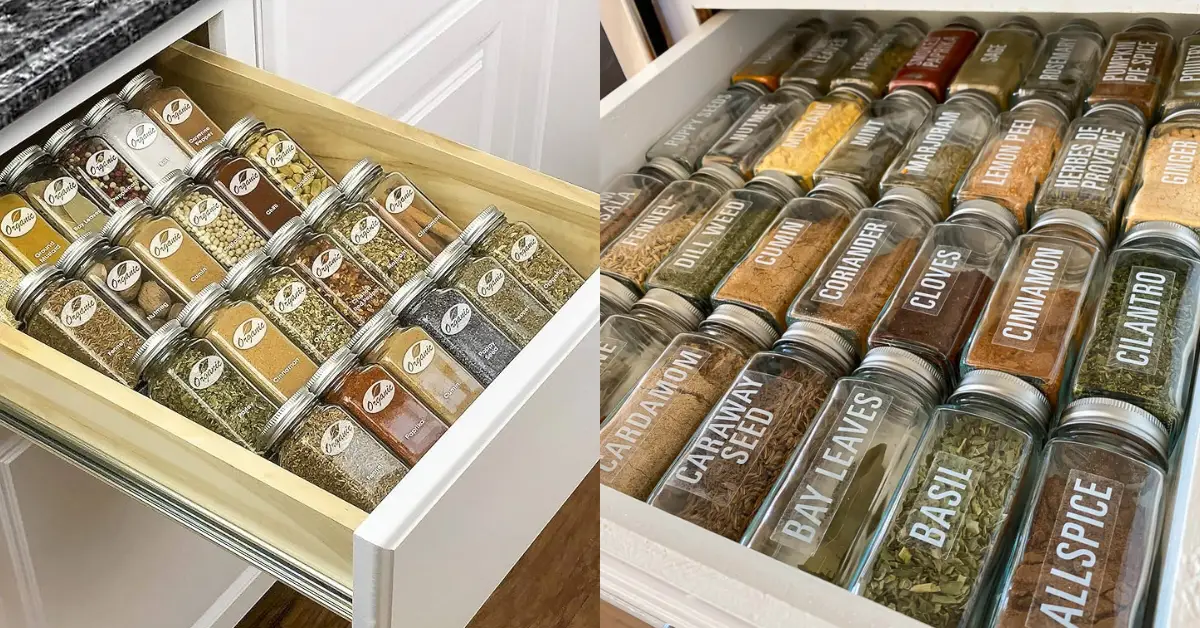
If you love a clean, uncluttered countertop, this is one of the smartest upgrades you can make. A deep drawer with tiered inserts lets you see every spice label at a glance, and nothing hides behind another. I’ve helped countless clients switch from crowded racks to drawer systems, and the first thing they always say is, “I had no idea I owned half these spices.”
A tiered layout works best because it gives you that bird’s-eye view — almost like looking at a neatly arranged spice catalog. You open the drawer, see what you need, and close it. No spills, no wasted space, no ugly plastic racks on your counter.
Here’s how to make it work:
- Use angled inserts so labels face up and are easy to read.
- Prioritize daily spices (salt, chili, turmeric) in the front row.
- Keep rarely used blends toward the back.
- Stick to the same jar height for a clean, uniform look.
This method works beautifully in modern or small kitchens because it hides the clutter but keeps accessibility top-notch. According to Her Happy Home, drawer storage also helps spices stay away from light and heat — meaning better flavor for longer.
Storage Idea 2 – Pull-Out Narrow Cabinet Next to the Stove
That tiny vertical gap between your stove and counter? It’s prime real estate you’re probably wasting. Installing a pull-out spice cabinet there turns that sliver of space into a powerhouse of convenience. When you’re mid-recipe, every second counts — and reaching sideways to grab cumin is a lot faster than crossing the kitchen.
I like this setup for people who cook daily or have a semi-professional workflow at home. It’s easy to clean, sleek, and saves you the trouble of opening multiple doors. Plus, it keeps bottles upright and organized by label.
Pro setup tips:
- Arrange spices by how often you use them — daily-use jars at eye level.
- Avoid putting this rack right next to heavy heat sources; leave a small buffer.
- Use narrow jars to maximize shelf count.
- Consider soft-close glides for smooth movement.
Storage Idea 3 – Wall-Mounted Open Shelves or Floating Ledges
Sometimes, you don’t want to hide your spices — you want to show them off. Wall-mounted shelves turn your spice collection into part of your kitchen’s décor. They’re ideal if you love to cook often and prefer everything visible and within arm’s reach.
This style works especially well above a prep counter or near a kitchen island. It’s functional, yes, but it also adds warmth and personality — those amber jars and copper lids can double as design accents.
What to keep in mind:
- Choose matching jars or at least the same color palette to keep it cohesive.
- Mount shelves away from direct sunlight or stovetop heat.
- Use two or three floating ledges rather than one wide unit — it’s easier to balance and clean.
- Label lids clearly if jars sit at eye level.
As Good Housekeeping notes, visible shelving can actually encourage better cooking habits because you see what you own — and use it more often. Just remember: style only works if it stays organized.
Storage Idea 4 – Magnetic Jars on the Fridge or Wall
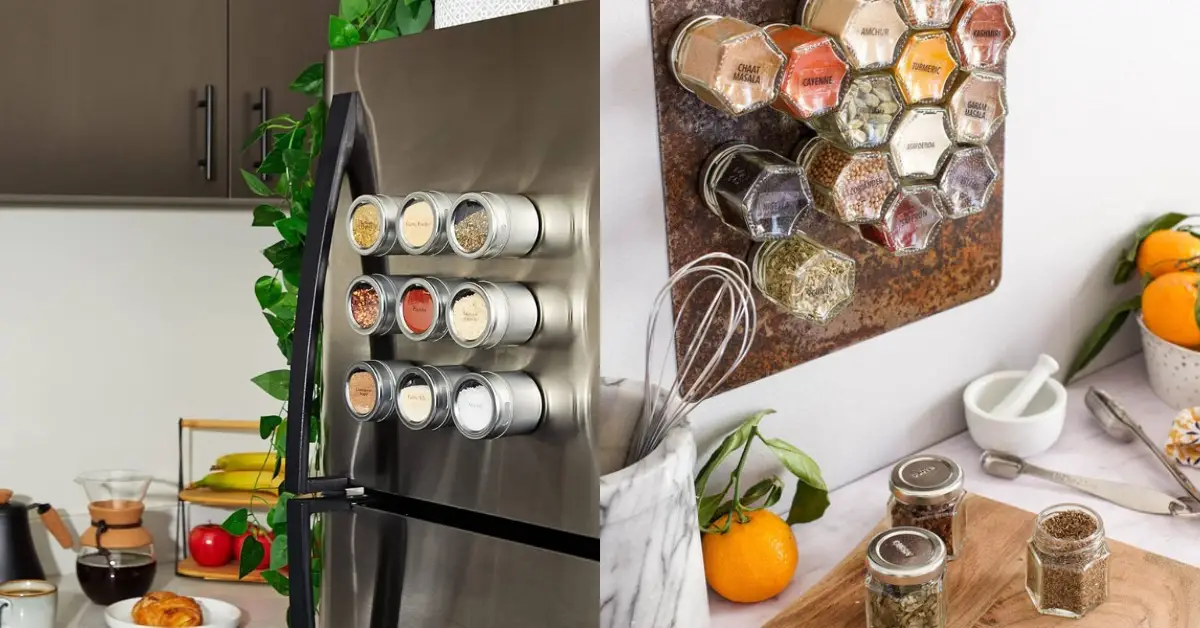
If you’re tight on space, this idea is a game changer. Magnetic spice jars stick to your fridge or a mounted metal sheet, freeing up your counters and drawers completely. It’s minimal, modern, and surprisingly functional — especially if you’re short on cabinets.
I first saw this hack years ago in a small studio kitchen, and it still stands out as one of the most creative uses of vertical space. It works best for cooks who like their essentials right in sight — grab, shake, move on.
How to do it right:
- Use metal lids and strong magnets to avoid slipping.
- Limit the wall display to 10–12 of your most-used spices — less is more.
- Wipe the jars occasionally; oil splatter and dust can dull the look.
- Arrange them in a grid or circular pattern to keep it visually balanced.
Magnetic racks not only save space but also add flexibility — you can move them, expand them, and clean around them easily. It’s a small-space solution that feels surprisingly high-end.
Storage Idea 5 – Tiered Risers Inside Cabinet or Pantry
Most of us only use the front few inches of our kitchen shelves, leaving the back half to become a graveyard of forgotten jars. Tiered risers fix that instantly. By lifting each row slightly higher than the one in front, you can finally see every spice you own — even the ones that usually get buried in the back.
I’ve used this setup in both small and large kitchens, and it’s always a game changer. It works especially well if you already have a deep cabinet but struggle to reach items tucked behind others.
How to make it work:
- Pick risers that fit the full width of your shelf for maximum stability.
- Label either the front edge of the riser or each jar lid for quick visibility.
- Only use risers if your cabinet has enough height clearance; otherwise, it’ll feel cramped.
- Combine with a lazy Susan on the lower shelf for easy access to oils or sauces.
Many people overlook this vertical advantage, but once you use it, you’ll realize how much easier it is to stay organized. If you’re short on shelf space or want to take your pantry organization even further, check out these 19 Clever Small Pantry Hacks for Maximum Storage — they pair perfectly with tiered risers to help you use every inch of your kitchen efficiently.
Storage Idea 6 – Over-the-Door or Inside Laundry Zone Storage
If your kitchen cabinets are already full, it’s time to look beyond them. The back of a pantry or even a laundry room door can become a surprisingly effective spice zone. It’s discreet, easy to reach, and perfect for storing overflow or backup jars.
This idea shines in apartments and small kitchens where cabinet real estate is precious. You’re essentially borrowing vertical space that’s been sitting unused all along.
Pro tips for setup:
- Choose shallow-depth racks so the door still closes smoothly.
- Store lesser-used spices here — things like pickling blends or seasonal mixes.
- Add clear labels and organize by cuisine or flavor profile.
- If you’re using a laundry area, keep spices away from direct heat or humidity.
It’s hidden but not forgotten — and it feels surprisingly satisfying to open a door and see a neatly lined-up collection that used to clutter your counters.
Storage Idea 7 – Countertop Lazy Susan or Carousel for Daily-Use Spices
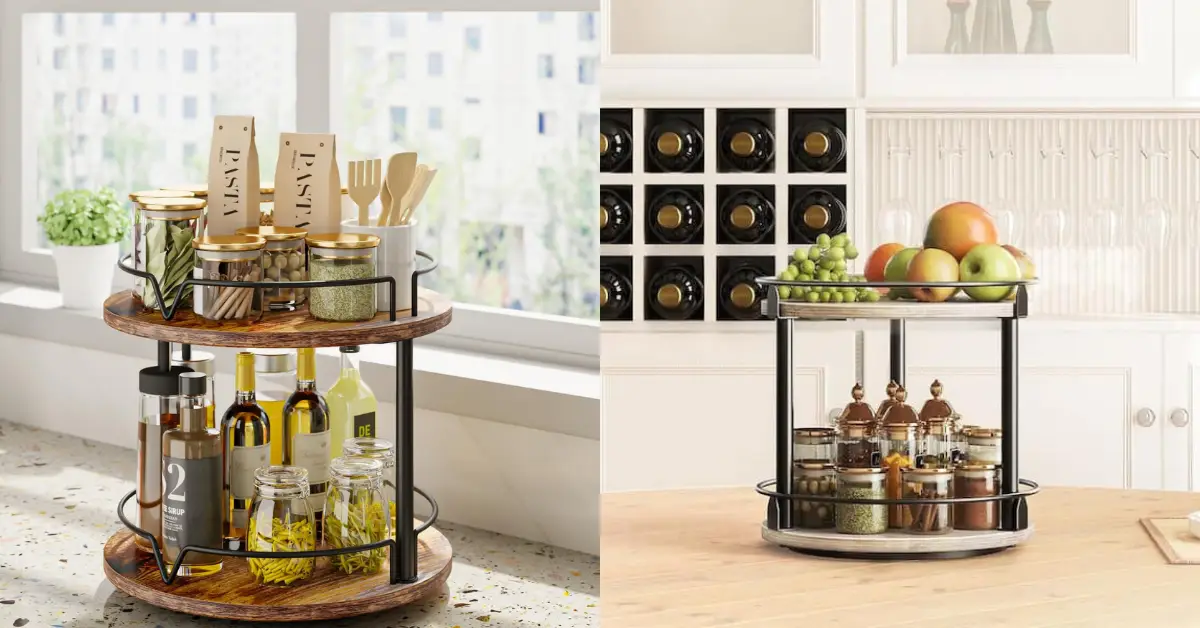
This is hands-down one of the most practical ideas for everyday cooks. A simple rotating tray — often called a lazy Susan — keeps your go-to spices within arm’s reach. Instead of rummaging through drawers or racks, you just spin and grab what you need.
It’s especially useful near the stove or prep area where you move fast and don’t have time to hunt for bottles. And the best part? It adds a little rhythm to your kitchen flow.
How to get the most out of it:
- Limit to 8–12 most-used spices to avoid clutter.
- Use matching jars for a clean, intentional look.
- Keep the tray on a non-slip mat to prevent sliding.
- Clean it weekly — since it’s exposed, dust builds up quickly.
It’s small, affordable, and ideal for cooks who want both function and a little bit of flair.
Storage Idea 8 – Hidden Drawer Beneath Countertop or Behind Toe-Kick
This is one of those “why didn’t I think of that” solutions. Many modern kitchen designs now include a slim drawer tucked right beneath the countertop or even in the toe-kick area — the recessed space below your lower cabinets.
These drawers are perfect for storing lesser-used or bulk spices that don’t need daily access. They free up prime space in your main drawers while keeping everything organized and close by.
Implementation tips:
- Label the drawer front clearly so you don’t forget what’s inside.
- Use it to store bulk refill containers or extra jars.
- Keep smaller, active jars in your main drawer or countertop area.
- Add drawer liners to prevent bottles from sliding.
It’s subtle, sleek, and especially useful in custom-built or renovated kitchens where every inch counts.
Storage Idea 9 – Pull-Out Pantry Insert for Large Spice Collections
If you’re a serious home cook or someone who experiments with global cuisines, you probably have a lot of spices. A pull-out pantry insert is your best friend here. These tall, narrow racks slide out smoothly and hold dozens of jars in neat, visible rows.
I recommend this for foodies, bakers, or anyone who stocks imported blends, seeds, or specialty salts. It’s a high-capacity solution that feels professional and saves you from juggling multiple boxes and bins.
Smart organizing ideas:
- Group spices by cuisine — Indian, Mediterranean, Asian, etc.
- Dedicate one shelf to “rarely used but essential” spices.
- Place daily-use blends at chest height for convenience.
- Add small LED strips or motion lights for visibility.
It’s like having a mini spice market in your own kitchen — efficient, elegant, and a true upgrade for passionate cooks.
Storage Idea 10 – DIY & Budget Alternative Hacks
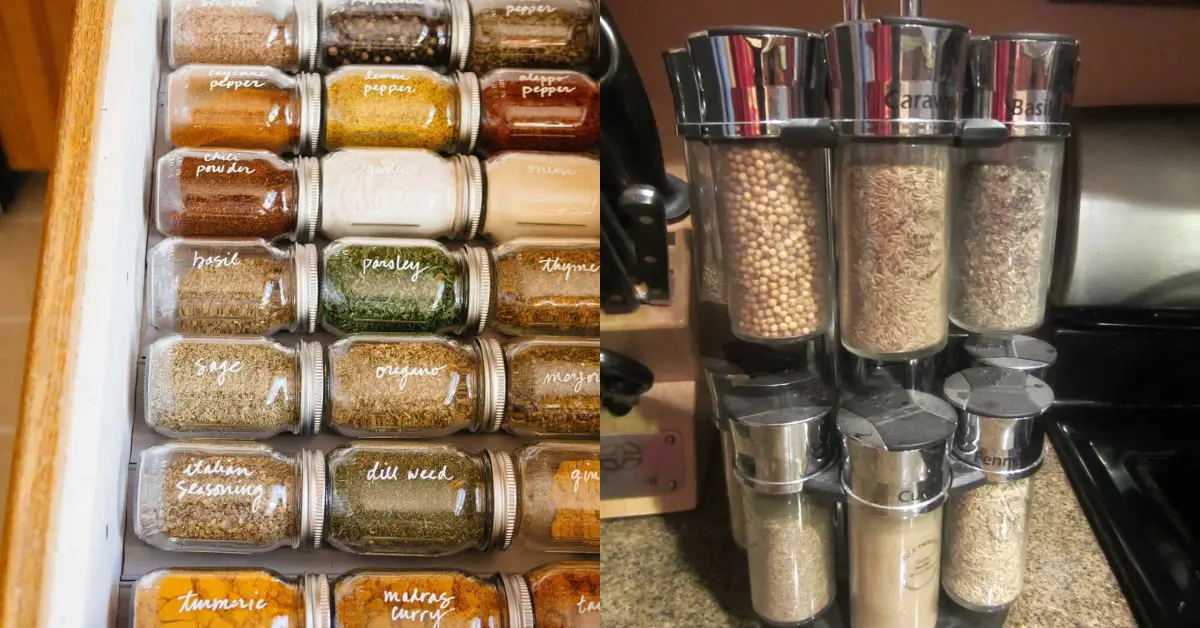
Not everyone wants to spend on new cabinetry or premium racks — and that’s completely fine. Some of the most creative spice setups I’ve seen were completely DIY. With a little imagination, you can create beautiful, functional storage using things you already own.
For instance, one clever home hack that went viral involved using picture frames in a narrow drawer to create a slanted spice rack. The frames fit perfectly and held the jars at the perfect angle for easy reading and access. It’s simple, budget-friendly, and surprisingly chic.
Other low-cost ideas worth trying:
- Repurpose old tea tins or mason jars for uniformity.
- Paint jar lids in matching tones for a cohesive look.
- Use a small bookshelf or crate as a spice station.
- Print color-coded labels for quick identification.
- Mount small hooks or shelves under cabinets for hanging jars.
The best DIY systems aren’t about perfection — they’re about personal comfort. Build something that matches how you cook, and your kitchen will naturally stay organized.
Maintain & Extend Your Spice System — What to Do After You’ve Set It Up
You’ve done the hard part — the sorting, labeling, and setting up. But here’s the truth: a spice system only stays efficient if you maintain it. Without regular care, even the most Pinterest-worthy setup can slip back into chaos. Think of this stage as upkeep for your kitchen’s sanity — quick habits that keep everything running smoothly and your flavors fresh.
Audit & Purge Expired or Little-Used Spices
Before organizing, it’s essential to start clean. According to Good Housekeeping, you should always discard expired spices and blends before setting up your system. Most ground spices lose their flavor in 6–12 months, while whole ones can last up to 2–3 years.
Try this:
- Open each jar and check aroma strength — faint smell = time to replace.
- Toss duplicates or half-used packets you never reach for.
- Use the space you reclaim to better showcase your essentials.
You’ll be surprised how much lighter and cleaner your spice area feels after one good purge. And while you’re sorting your spice jars, it’s the perfect time to check your pantry for hidden troublemakers too — like pantry moths that often sneak in through old flour or herbs. Here’s a quick guide on 7 Mistakes That Attract Pantry Moths (and How to Fix Them Fast) to help you keep both your spices and dry goods safe.
Labeling and Grouping for Faster Cooking
A smart labeling and grouping system turns your kitchen into an efficient workspace. Instead of scanning 40 jars for cinnamon, you’ll know exactly where to reach.
Best grouping ideas:
- Baking spices: cinnamon, nutmeg, cloves, vanilla sugar
- Savory herbs: thyme, rosemary, oregano, basil
- World cuisines: curry, za’atar, garam masala, chili blends
- Everyday essentials: salt, pepper, chili flakes, cumin
Use printed or hand-lettered labels — whichever fits your style — but make sure they’re consistent. The goal is quick recognition at a glance.
Keep Near Where You Cook (But Away from Heat/Sunlight)
Even if your rack looks stunning beside the stove, that heat isn’t doing your spices any favors. Food Network emphasizes that light and warmth are flavor killers — they break down essential oils that give spices their aroma.
Quick reminders:
- Store within reach, but at least a few feet from direct heat.
- Avoid windowsills and open shelving above ovens.
- If you love visible jars, use tinted glass to reduce exposure.
Think of it as finding the “sweet spot” — accessible but protected.
Periodic Refresh and Reorder Habit
Organization isn’t a one-time project; it’s a rhythm. I recommend setting a reminder every few months to refresh your setup. It takes less than 15 minutes but keeps your system tight and functional.
Quarterly check routine:
- Reorder jars alphabetically or by usage frequency.
- Wipe any residue or grease off lids and racks.
- Refill blanks and note any spices running low.
- Swap out old labels if they’ve faded.
Little check-ins like these prevent clutter from creeping back and keep your space ready for any recipe that comes your way.
Quick Comparison Table – Which System Fits Your Kitchen?
| Kitchen Type / Cooking Style | Ideal Storage Idea(s) | Budget Range | Best For |
|---|---|---|---|
| Small Apartment / Minimal Cook | Magnetic jars, over-the-door rack | Low | Quick meals, tight spaces |
| Busy Family Kitchen | Pull-out cabinet, tiered drawer, lazy Susan | Medium | Everyday cooking, fast access |
| Avid Home Chef / Foodie | Pull-out pantry insert, floating shelves | High | Large spice variety, global flavors |
| Organized Minimalist | Drawer with angled inserts, hidden toe-kick drawer | Medium | Sleek design, clean counters |
| DIY Enthusiast | Repurposed jars, picture frame risers, crates | Low | Creative setups, personalized touch |
Wrapping Up & Next Steps
You don’t need to redo your entire kitchen to make it work better — you just need one intentional change. Whether it’s a pull-out drawer, magnetic rack, or DIY riser, the right spice setup instantly transforms how you cook and feel in your space.
Remember, storage isn’t a one-time fix — it’s a habit. Once you’ve found a system that fits your lifestyle, those small habits (like refilling, labeling, or purging) will keep it running smoothly for years. And as you refresh your spice area, don’t forget about kitchen safety — especially if you store food and spices in shared spaces. Read 10 Pantry Dangers to Avoid for a Safe, Clean HomeFdata to make sure your storage setup not only looks great but stays safe too.
So here’s your next step: Pick one of the 10 ideas from above and implement it within the next 48 hours. Start with the zone you use most — your drawer, wall, or pantry. Take a before-and-after picture, and you’ll see how even one change can make your kitchen feel brand new.
Ready to transform your kitchen into a space that actually works for you? Head to Build Like New and explore more real, doable ideas that make your home feel fresh every day.
Disclaimer: The information and tips in this article are based on general home organization practices and personal experience. Results may vary depending on your kitchen layout, product quality, and maintenance habits. Always check manufacturer instructions before installing or modifying any storage system.


